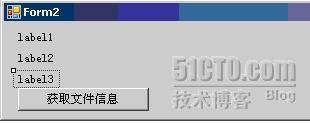3-1 Fileinfo类的常用方法
发布时间:2019-09-20 07:29:22编辑:auto阅读(2297)
1. 案例学习:了解FileInfo类的一些主要属性
下面的示例演示了 FileInfo类的一些主要属性。
|
using System;
using System.IO;
class Test
{
public static void Main()
{
string fileName = "C:\\autoexec.bat";
FileInfo fileInfo = new FileInfo(fileName);
if (!fileInfo.Exists)
{
return;
}
Console.WriteLine("{0} has a directoryName of {1}",fileName,fileInfo.DirectoryName);
/* 下面是代码的处理结果,
* 实际的结果因机器不同:
*
* C:\autoexec.bat has a directoryName of C:\
*/
}
} |
2.案例学习:实现文件的复制
本案例将解决,同磁盘环境下文件复制的问题。请尝试把C:\WinNT\Win.INI文件拷贝到C:\下的代码,怎么写呢?
u实验步骤(1):
向一个Form窗体上拖拽三个Button控件,三个控件的text属性分别设置为“复制文本文件”、“创建文本文件”、 “删除文本文件”。如图3-3所示:

图3-3 文件操作界面图
u实验步骤(2):
双击“复制文本文件”、“创建文本文件”、“删除文本文件”,在click事件处理方法里分别添加代码如下:
|
using System;
using System.Collections.Generic;
using System.ComponentModel;
using System.Data;
using System.Drawing;
using System.Text;
using System.Windows.Forms;
using System.IO;
namespace FileOptionApplication
{
public partial class Form1 : Form
{
public Form1()
{
InitializeComponent();
}
/// <summary>
/// 复制文本文件
/// </summary>
private void button1_Click(object sender, EventArgs e)
{
string somefile = @"C:\Documents and Settings\Administrator\My Documents\SQL Server2000安装故障.txt";
string target = @"c:\2.txt";
if (!File.Exists(somefile))
{
MessageBox.Show("文件不存在!");
}
else
{
if (File.Exists(target))
{
File.Delete(target);
}
File.Copy(somefile, target);
MessageBox.Show("文件复制成功!");
}
}
/// <summary>
/// 创建文本文件
/// </summary>
private void button2_Click(object sender, EventArgs e)
{
string target = @"c:\2.txt";
if (File.Exists(target))
{
File.Delete(target);
}
File.CreateText(target);
}
/// <summary>
/// 删除文本文件
/// </summary>
private void button3_Click(object sender, EventArgs e)
{
string target = @"c:\2.txt";
if (File.Exists(target))
{
File.Delete(target);
MessageBox.Show("文件删除成功!");
}
}
}
} |
刚才的实验我们是通过File类实现并完成任务的,那么此次我们通过更换FileInfo类执行同样的复制动作如何实现呢?请将button1_Click的代码替换为下列代码试试:
|
private void button1_Click(object sender, EventArgs e)
{
string path = @"C:\WINDOWS\IE4 Error Log.txt";
string target = @"c:\1.txt";
FileInfo myfile = new FileInfo(path);
if (!myfile.Exists)
{
MessageBox.Show("对不起,未发现路径文件!");
}
else
{
myfile.CopyTo(target);
MessageBox.Show("复制成功!");
}
} |
3.案例学习:获取文件基本信息
本案例将解决,如何显示文件的基本信息问题。
u实验步骤(1):
向一个Form窗体上拖拽三个Lable控件和一个Button控件,Button控件的text属性设置为“获取文件信息”。如图3-4所示:

图3-4 获取文件信息界面图
u实验步骤(2):
双击“获取文件信息”,在click事件处理方法里分别添加代码如下:
|
using System;
using System.Collections.Generic;
using System.ComponentModel;
using System.Data;
using System.Drawing;
using System.Text;
using System.Windows.Forms;
using System.IO;
namespace FileOptionApplication
{
public partial class Form2 : Form
{
public Form2()
{
InitializeComponent();
}
/// <summary>
/// 获取文件信息单击事件
/// </summary>
private void button1_Click(object sender, EventArgs e)
{
string somefile = @"C:\Documents and Settings\Administrator\My Documents\SQL Server2000安装故障.txt";
FileInfo myfile = new FileInfo(somefile);
if (myfile.Exists)
{
MessageBox.Show("文件已经存在");
label1.Text = "文件创建时间:" + myfile.CreationTime.ToString();
label2.Text = "文件夹:" + myfile.Directory.ToString();
label3.Text = "文件夹名称:" + myfile.DirectoryName.ToString() + ",文件扩展名:" + myfile.Extension.ToString();
}
else
{
MessageBox.Show("文件并不存在");
}
}
}
} |
FileInfo类和File类都可以实现上述操作,它们的方法也都非常相似,那么它们到底有什么区别呢?
nFileInfo类和File类的比较
n两者都提供对文件类似的操作。
nFile为静态类,直接使用;FileInfo需要实例化后才能使用 。
n从性能上考虑,如果你要多次操作文件,不管是针对相同的,还是不同的,请使用FileInfo,说白了,单打独斗File最棒,群殴则首推FileInfo。
n每次通过File类调用某个方法时,都要占用一定的CPU,而FileInfo类只在创建FileInfo对象时执行一次安全检查。
上一篇: Python读写CSV文件
下一篇: Python学习笔记整理(二)pytho
- openvpn linux客户端使用
51739
- H3C基本命令大全
51408
- openvpn windows客户端使用
41829
- H3C IRF原理及 配置
38599
- Python exit()函数
33093
- openvpn mac客户端使用
30088
- python全系列官方中文文档
28758
- python 获取网卡实时流量
23756
- 1.常用turtle功能函数
23670
- python 获取Linux和Windows硬件信息
22037
- Ubuntu本地部署dots.ocr
60°
- Python搭建一个RAG系统(分片/检索/召回/重排序/生成)
2258°
- Browser-use:智能浏览器自动化(Web-Agent)
2950°
- 使用 LangChain 实现本地 Agent
2462°
- 使用 LangChain 构建本地 RAG 应用
2406°
- 使用LLaMA-Factory微调大模型的function calling能力
2999°
- 复现一个简单Agent系统
2417°
- LLaMA Factory-Lora微调实现声控语音多轮问答对话-1
3213°
- LLaMA Factory微调后的模型合并导出和部署-4
5304°
- LLaMA Factory微调模型的各种参数怎么设置-3
5124°
- 姓名:Run
- 职业:谜
- 邮箱:383697894@qq.com
- 定位:上海 · 松江
